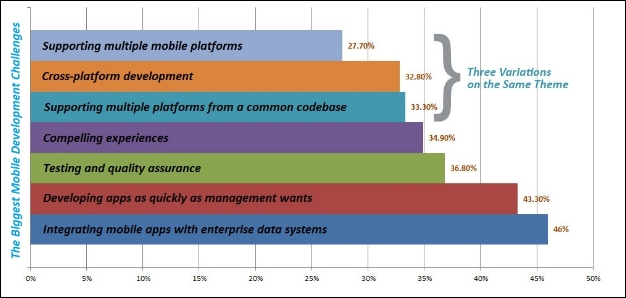We all know that today everyone is addicted to mobile phones. As per a survey, more than two hundred millions of smart phones, tablets and air books already used in the world. This evolution shows new big changes to the form factor of software solutions. At the moment mobile applications are most required applications by all companies for their e-commerce plan.
Generally, users of the mobile phones in overall pay attention to the user experience, and when they have choice they prefer more native look and feel be it for email, social networking, checking weather, sport events etc. Even Google, one of the biggest software companies, is building native applications. Most of the developers can emulate a native experience in the browser thanks to the progress made by Web Kit.

Threats for Mobile Applications:
If these changes can already importantly have an impact to a mobile solution delivery process, the most deepening architectural change introduced from mobility is an evolution from connected applications to be united applications where voice, messages, location services, data services and video can all contribute for delivering an experience simply unavailable to a desktop or a web application.
In the start of the 2000s, in the wake of SOA, several companies had developed the concept of Composite Applications or Connected Systems. This concept is advanced by the mobile applications to the next level, and was enabled as an arbitrary application which was used for recording mash up of any number of voice, messaging, data, location and video services end user etc independent of the application.
Converged Applications have created strong privacy standards like OAuth 2.0 has emerged to support this scenario. OAuth 2.0 is application which has requirements to maintain individual API keys and (user) access tokens for each single type of services. The developer cannot rely more on a single sign of mechanism such as OpenID or LivelD( single id used for multiple accounts) because they are sharing the identity of the subscriber with these type of application and they do not provide any authorization.
Coverget applications are usually requested to perform in a downgraded mode when the user does not grant the application full consent for consuming all of the services on his or her behalf.
Technologies which are used in mobile applications
There are about four major categories of technologies which are used in mobile applications which are as follows:
- Web–based (HTML5/CSS3/JS) and related Frameworks (JQuery, Sencha, …)
- Native platforms (iOS, Android, Windows Mobile 7…)
- Hybrid WebKit/Native
- Proprietary middleware and clients (Red Foundry,…)
Great Chances in the field of Mobile App Development:
There are also two approaches to facilitate the development of cross platform mobile applications:
-
- Thin Native Clients that provides access to a native APIs and/ or render Web-based applications who have a native look and feel (PhoneGap, AppMobi, AppCelerator…)
- Domain Specific Language from which is generated native or Web-based code(Applause, Mobl, Canappi…)
Wind up:
So, with these threats and chances it becomes sometimes difficult to create a sound mobile app. Well, if you face any difficulty in developing any mobile application then you can get in touch with experts at Platinum SEO, Melbourne based skilled developer for mobile app, where clients get what they want with deepest satisfaction.